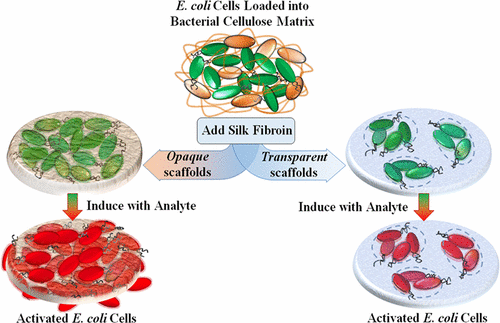当前位置:
X-MOL 学术
›
ACS Biomater. Sci. Eng.
›
论文详情
Our official English website, www.x-mol.net, welcomes your
feedback! (Note: you will need to create a separate account there.)
Immobilization of Recombinant E. coli Cells in a Bacterial Cellulose–Silk Composite Matrix To Preserve Biological Function
ACS Biomaterials Science & Engineering ( IF 5.4 ) Pub Date : 2017-09-13 00:00:00 , DOI: 10.1021/acsbiomaterials.7b00367 Irina Drachuk 1, 2 , Svetlana Harbaugh 2, 3 , Ren Geryak 4 , David L. Kaplan 5 , Vladimir V. Tsukruk 4 , Nancy Kelley-Loughnane 2
ACS Biomaterials Science & Engineering ( IF 5.4 ) Pub Date : 2017-09-13 00:00:00 , DOI: 10.1021/acsbiomaterials.7b00367 Irina Drachuk 1, 2 , Svetlana Harbaugh 2, 3 , Ren Geryak 4 , David L. Kaplan 5 , Vladimir V. Tsukruk 4 , Nancy Kelley-Loughnane 2
Affiliation

|
Strategies for the encapsulation of cells for the design of cell-based sensors require efficient immobilization procedures while preserving biological activity of the reporter cells. Here, we introduce an immobilization technique that relies upon the symbiotic relationship between two bacterial strains: cellulose-producing Gluconacetobacter xylinus cells; and recombinant Escherichia coli cells harboring recombinase-based dual-color synthetic riboswitch (RS), as a model for cell-based sensor. Following sequential coculturing of recombinant cells in the cellulose matrix, final immobilization of E. coli cells was completed after reconstituted silk fibroin (SF) protein was added to a “living membrane” generating the composite bacterial cellulose-silk fibroin (BC-SF) scaffold. By controlling incubation parameters for both types of cells, as well as the conformations in SF secondary structure, a variety of robust composite scaffolds were prepared ranging from opaque to transparent. The properties of the scaffolds were compared in terms of porosity, water capacity, distribution of recombinant cells within the scaffolds matrix, onset of cells activation, and ability to protect recombinant function of cells against UV irradiation. The closer-fitted microstructure of transparent BC-SF scaffolds resulted in leakage-free encapsulation of recombinant cells with preserved RS function because of a combination of several parameters that closely matched properties of a biofilm environment. Along with proper elasticity, fine porosity, capacity to retain the water, and ability of SF to absorb UV light, the composite hydrogel material provided necessary conditions to form confined cell colonies that modified cell metabolism and enhanced cell resilience to the stresses induced by encapsulation.
中文翻译:

将重组大肠杆菌细胞固定在细菌纤维素-丝绸复合基质中以保持生物学功能
用于设计基于细胞的传感器的细胞封装策略需要有效的固定程序,同时保留报告细胞的生物学活性。在这里,我们介绍一种固定化技术,该技术依赖于两种细菌菌株之间的共生关系:产生纤维素的木糖葡糖杆菌细胞;带有基于重组酶的双色合成核糖开关(RS)的重组大肠杆菌细胞,作为基于细胞的传感器的模型。重组细胞在纤维素基质中的顺序共培养后,大肠杆菌的最终固定化将重组的丝素蛋白(SF)蛋白添加到“活膜”中后,细胞就完成了,生成了复合细菌纤维素-丝素蛋白(BC-SF)支架。通过控制两种细胞的孵育参数以及SF二级结构的构象,可以制备从不透明到透明的各种坚固的复合支架。根据孔隙率,水容量,支架基质内重组细胞的分布,细胞活化的开始以及保护细胞的重组功能免受紫外线照射的能力,比较了支架的性质。透明BC-SF支架的紧密配合的微观结构导致具有保留的RS功能的重组细胞的无泄漏封装,这是因为几个参数的组合与生物膜环境的性质紧密匹配。除了适当的弹性,良好的孔隙率,保水能力和SF吸收紫外线的能力外,复合水凝胶材料还提供了形成受限细胞集落的必要条件,这些集落改变了细胞的新陈代谢并增强了细胞对包囊诱导的应激的适应力。
更新日期:2017-09-13
中文翻译:

将重组大肠杆菌细胞固定在细菌纤维素-丝绸复合基质中以保持生物学功能
用于设计基于细胞的传感器的细胞封装策略需要有效的固定程序,同时保留报告细胞的生物学活性。在这里,我们介绍一种固定化技术,该技术依赖于两种细菌菌株之间的共生关系:产生纤维素的木糖葡糖杆菌细胞;带有基于重组酶的双色合成核糖开关(RS)的重组大肠杆菌细胞,作为基于细胞的传感器的模型。重组细胞在纤维素基质中的顺序共培养后,大肠杆菌的最终固定化将重组的丝素蛋白(SF)蛋白添加到“活膜”中后,细胞就完成了,生成了复合细菌纤维素-丝素蛋白(BC-SF)支架。通过控制两种细胞的孵育参数以及SF二级结构的构象,可以制备从不透明到透明的各种坚固的复合支架。根据孔隙率,水容量,支架基质内重组细胞的分布,细胞活化的开始以及保护细胞的重组功能免受紫外线照射的能力,比较了支架的性质。透明BC-SF支架的紧密配合的微观结构导致具有保留的RS功能的重组细胞的无泄漏封装,这是因为几个参数的组合与生物膜环境的性质紧密匹配。除了适当的弹性,良好的孔隙率,保水能力和SF吸收紫外线的能力外,复合水凝胶材料还提供了形成受限细胞集落的必要条件,这些集落改变了细胞的新陈代谢并增强了细胞对包囊诱导的应激的适应力。











































 京公网安备 11010802027423号
京公网安备 11010802027423号